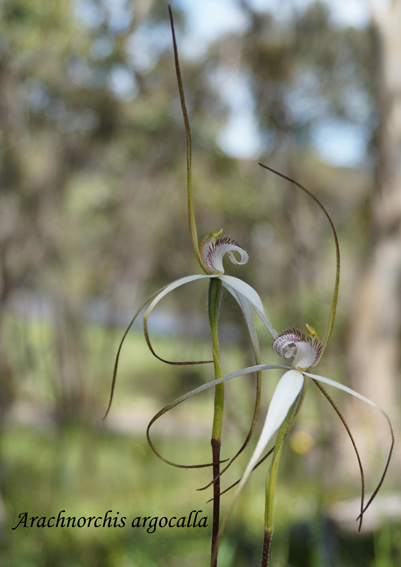Tag: Thelymitra benthamiana
2017 August Winning Picture
The following article appeared in the Native Orchid Society of South Australia Journal September 2017 Volume 41 Number 8. It is a longer and expanded version of the article as George Bentham was one of most influential botanists of the 19th century making it difficult to summarize his life. Even this article barely scratches the surface of this most interesting man.
The theme for the August competition was Striped or Blotched orchids.

Blotches or stripes, which one? An interesting collection was entered. Representing the stripes were John Fennell’s Dipodium pardalinum, Shane Grave’s Cyrtostylis robusta labellum, Helen Lawrence’s Thelymitra cyanea, Robert Lawrence’s Diplodium dolichochilum and Lorraine Badger’s T. campanulata. There were less blotches; Ricky Egel’s Diuris pardina and John Fennell’s T. benthamiana.
T. benthamiana (Leopard Sun Orchid) is a popular orchid to photograph and it is not surprising that it is again (see April 2016) a winner in our competition. It was named after the Englishman George Bentham (1800 – 1884) one of the foremost and influential systemic botanists of the 19th century. At about the age of 16 or 17 years he was introduced to botany, and despite training as a lawyer, he devoted his life to the study of botany.
Though never visiting Australia, he produced the world’s first completed continental flora, Flora Australiensis, a seven volume work produced over 15 years (1863 – 1878). As monumental as this was, at the same time he was working on his greatest work, co-authored with Joseph Dalton Hooker, Genera Plantarum (1862 – 1883) in which is introduced the Bentham & Hooker system of plant classification. This system is still in use by many herbaria around the world. It involved the study of actual plant specimens, a practice which Bentham used himself. For instance, in the production Flora Australiensis, he would examine, critique and describe over a 1,000 species each year.
This practice harkens back to his early days when in his Flora of the French Pyrenees (1826) he adopted the practice of citing nothing second-hand. He never deviated from this. It did help that he was able to read in fourteen modern European languages plus having a good command of Latin, the language used for many botanical writings. This enabled him to access original material which he did by visiting every European herbarium when preparing for his first major work Labiatarum Genera et Species (1832 – 1836).
A shy and unassuming man, Bentham had the respect of the botanical world as was reflected in the various awards he received. Described as a genius, [a man of] indefatigable industry, the premier systematic botanist, he considered himself an amateur botanist, never a professional, even though he donated his extensive collection of more than 1,000 specimens to Kew Gardens in 1854 where he worked full time until his death in 1884. Bentham lived in, and contributed to, the transitional period from the dominance of the gentleman botanist to the government being responsible for collections of national and scientific significance.
He was responsible for introducing into orchid taxonomy (1881) a new classification recognising Subtribes, which precedes Genus in the classification system; introduced the word ‘orchidologist’ to the world in his Notes on Orchideae, 1881. Although there is only one Australian orchid named after Bentham, he has a whole genus of 29 species named after him: Benthamia which is endemic to Madagascar, Mauritius and Reunion. Worldwide, Bentham was directly involved in naming over 200 orchid taxa.
Thanks to Greg Steenbeeke for critiquing this article.
Reference
N. T. Burbidge, ‘Bentham, George (1800–1884)’, Australian Dictionary of Biography, National Centre of Biography, Australian National University, http://adb.anu.edu.au/biography/bentham-george-2979/text4345 , published first in hardcopy 1969, accessed online 29 August 2017.
George Bentham Retrieved August 31, 2017 https://en.wikipedia.org/wiki/George_Bentham
The Taxonomy of the Orchidaceae Retrieved 31 August 2017 from https://en.wikipedia.org/wiki/Taxonomy_of_the_Orchidaceae
Bentham, George (DNB00). (2012, December 29). In Wikisource. Retrieved August 31, 2017, from https://en.wikisource.org/w/index.php?title=Bentham,_George_(DNB00)&oldid=4211195
Bentham and Hooker system of Classification. Accessed August 31, 2017 from http://vle.du.ac.in/mod/book/print.php?id=13270&chapterid=29150
Notes on Orchidaea (Journal of the Linnean Society)
English Oxford Living Dictionary. Accessed 31 August, 2017 from https://en.oxforddictionaries.com/definition/orchidologist
UPSIDE UPSIDE DOWN
Leo Davis always has some interesting insights from his orchid observations. In this article he examines the position of the tepals (petals and sepals) in particular the Moose Orchid which he saw for the first time this year.
Have a close look, next season (winter to early summer) at some of our native lilies. Start with the jolly bulbine lily (Bulbine bulbosa), no longer a true lily incidentally, because it now resides in family Aspodelaceae, along with the grass trees. You will find three yellow petals at 12, 4 and 8 o’clock and closely behind them three almost identical sepals at 2, 6 and 10 o’clock, so at first sight you see six apparently identical tepals (sepals and petals). Move on to the rush fringe-lily (Thysanotus juncifolius), as described in Ann Prescott’s ‘It’s Blue With Five Petals’. Clive Chesson is more up to date and tells me it is now T. racemoides. Again it is no longer a true lily, now sitting in family Asparagaceae. Here the tepals are noticeably different. Three wide densely fringe edged petals will be found, if you view the flower face on, at 12, 4 and 8 o’clock. The narrow non fringed sepals sit close behind at 2, 6 and 10 o’clock. These are just a generalisations because if the flower turns only about 60o a sepal will be at the top.
Most orchids, while close relatives of the true lilies and the one time lilies, do not show these arrangements. Let’s start with some that do.
In the large duck orchid (Caleana major) the petal at 12 o’clock, the dorsal petal, is modified, as in most, but as usual, not all, orchids, to become a labellum. In this charmer the labellum takes the form of a duck’s head. Its function is to snap down trapping a pollinator insect in the cup shape column below it, forcing it into contact with the sticky off white stigma and/or the yellow pollinia below it. Look closely and you will find the other two narrow petals drooping at around 4 and 8 o’clock. Two folded, twisted sepals can be clearly seen at around 1 and 11 o’clock. The third sepal, at 6 o’clock, is tucked in behind the cup shaped column. Note that, as with lilies, the top tepal is a petal.
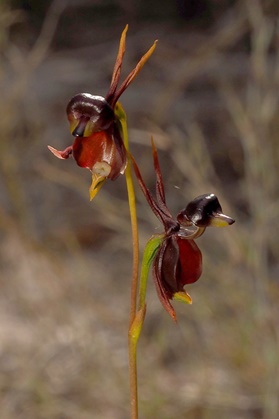
The leek orchids (genus Prasophyllum) follow this pattern and also have their labellum at around 12 o’clock. These orchid groups, which are up the right way, are said to be ‘not upside down’, using the technical term ‘non resupinate’.
Most orchids are ‘upside down’ and are called resupinate. The whole flower rotates 180o, clockwise or anti I don’t know, at the embryonic stage. But let’s start with somewhat of an exception with the sun orchids (genus Thelymitra) which do not have a petal modified as a labellum. But they are indeed upside down.
Have a close look at the Thelymitra benthamiana flower. Note that the three petals, at roughly 2, 6 and 10 o’clock, are in front of the three slightly larger but very similar sepals, at 12, 4 and 8 o’clock.
Note that the top tepal is a sepal. The flower is upside down, that is resupinate. In most orchids the petal at 6 o’clock would be modified to be a labellum.
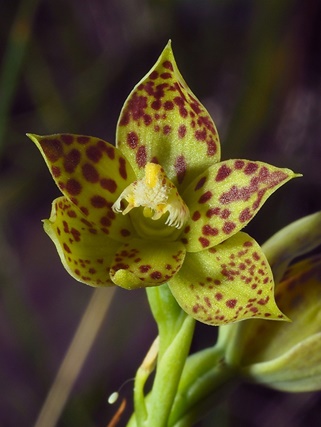
The Arachnorchis (possibly Caladenia to you) stricta, from Sherlock, out in the mallee, is more typical of terrestrial orchids in SA. It is upside down, that is resupinate, and has a petal modified to be a labellum.
The bottom petal has become a wide labellum, with fine edge combs and parallel rows of rich plum coloured calli covering its centre. Out at roughly 3 o’clock is a narrow petal, the other invisible on the other side. At the top, pressed tightly against the column, a sepal arches forward. Two larger sepals extend down at around 5 and 7 o’clock.
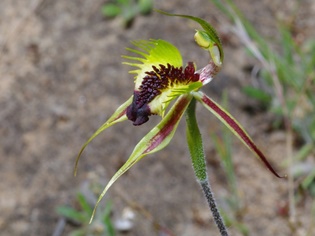
When I saw my first, my only, moose orchid, this season, I was in such a state of excitement that it looked to me to be up the right way, that is to say upside down.
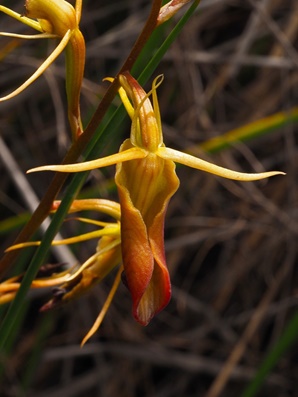
Have a look. Two narrow short roughly vertical petals at about 1 and 11 o’clock. There are two sepals at just past 3 and just before 9 o’clock. That’s OK but where is the other sepal? Are there it is, where it should be, at midday. But hang on, it’s behind the flower stem (peduncle) and where is the column?
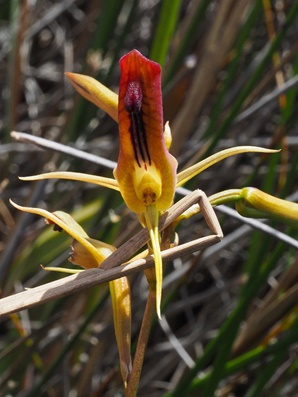
Holding the labellum up with a stick I found the column, the stigma and the pollinia, underneath the labellum. The third sepal now appears to be at 6 o’clock. And it all became clear. This flower was up the right way (non resupinate) but it has turned forward, on its peduncle, by about 180o, to become upside down, but not in the manner of resupinate flowers, because it is back to front. It is an inverted non resupinate flower. Still with me?
2016 Orchid Picture of the Year
For the final meeting of the year we chose the best of the 2016 monthly winners of the picture competition.
Here in Australia we are fortunate to have such a variety of orchids. They may not be as big and showy as some of the overseas orchids but the diversity of shapes fires the imagination as reflected in this year’s monthly winners, when put together. The common names of the winners – spider, leopard, flying duck, cowslip, zebra, helmet, bluebeard and greenhood – reinforce this theme of diversity.
Patterns and colours contribute to the variety of our orchids. Australian orchid colours run the gamut of the rainbow and more, with Australia being home to most of the naturally occurring blue orchids in the world. This colour fascinates and allures people around the world so much so that nurseries will dye a white orchid blue because it will sell. There is even a website devoted to the colour called, not surprisingly, Blue Orchid and the popular band master Glenn Miller wrote a song titled Blue Orchids (1944).
Could this be why the very clear winner for the year was Claire Chesson’s Pheladenia deformis common name Bluebeard or Blue Fairy?

Claire Chesson on your most beautiful picture.

Claire won the August competition.
As a reminder, below are the other winners for the year. Click on the image to see the related articles.
February 2016 Photographer: Pauline Meyers

March 2016 Photographer: Judy Sara
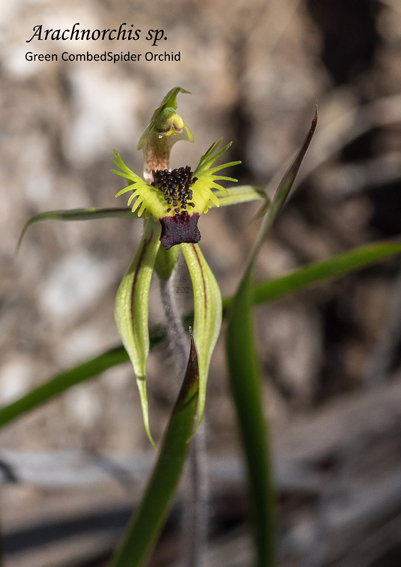
April 2016 Photographer: Claire Chesson

May 2016 Photographer: Pauline Meyers

2016 June Photographer: Ros Miller

2016 July Photographer: Robert Lawrence

2016 September Photographer: Bevin Scholz

2016 October Photographer: Helen Lawrence
Mad Dogs and …. Orchidologists
Mad dogs and Englishmen are not the only ones to go out in the midday sun. For orchidologists to see Sun Orchids flowering, then it is out into the midday sun on a hot day because that is when they open. There is no point going much before 11am and by 2pm most are closing and no point going out on a cool or windy day.
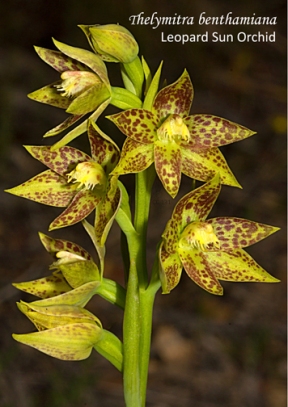
But for those who don’t want to go out (or cannot get out) into the midday sun, here is a video to be viewed in the cool of the shade.
This video features the Leopard Sun Orchid (Thelymitra benthamiana) an uncommon Sun Orchid in South Australia. Unlike many sun orchids which requires a view of the flower to confirm identification, this one can be identified by the leaf alone. At the beginning of the video take note of its distinctive leaf.

April 2016 Winning Picture Competition

Five entries were received, again spanning the country from east to west. John Badger entered a Chiloglottis reflexa recently photographed in Tasmania, Pauline Meyers an unidentified Western Australian Spider orchid, Judy Sara had two entries from the latest field trip, Eriochilus collinus (previously phrase name Adelaide Hills) and Leporella fimbriata and Claire Chesson’s Thelymitra benthamiana.
T. benthamiana, the winning picture, is a beautiful sun orchid that is found across the southern Australia from Western Australia through South Australia to Victoria and Flinders Island. More common in west than elsewhere it is the only one of the seven species in the T. fuscolutea complex to be found in the east.
It would appear that this complex has been a problematic as indicated by Jeanes (2006) in his article Resolution of the Thelymitra fuscolutea (Orchidaceae) complex of southern Australia published Muelleria; the Royal Botanic Gardens of Victoria research journal.
Since the early days confusion, which persisted into this millennium, has occurred. In 1871 Reichenbach recognised 3 species one of which was T benthamiana but Bentham after whom the orchid was named disagreed and consider it but a synonym of T. fuscolutea. There were many twists and turns in the names but in effect, for over a hundred years, most authors followed Bentham’s taxonomy rather than Reichenbach’s until 1989 when Mark Clements after studying the drawings, literature and orchid type material came to the same conclusion as Reichenbach that T. benthamiana was a distinct species from T. fuscolutea. Since then, authors have followed Reichenbach/Clements taxonomy.
Over the decades, the number of species in this complex varied considerably. By 1938 three separate species were recognised, but between then and 1989 it fluctuated between recognizing one, three and four species and in 1998 the orchidologist were considering a possible seven species. These were all confirmed and named in Jeans’ 2006 paper. Today, according to Orchids of Western Australia there is potentially an eighth member in this group.
Jeanes highlights some of the issues involved in determining which species is which. Some of the issues are lack of accurate/detailed information such as location, type of terrain, habitat, surrounding plants, date of collection, etc. Dried specimens by themselves are inadequate as important features may be lost in the drying process.
This complex is but an example of a widespread problem across many of our Australian orchids indicating not only the need for careful observations in the field but meticulous record keeping that others can access.
References
Jeans J A, Resolution of the Thelymitra fuscolutea R. Br. (Orchidaceae) complex of southern Australia. Muelleria 24: 3-24 (2006)
Brown A, et al, Field Guide to the Orchids of Western Australia, 2013
Thank you to Juergen Kellermann, (senior botanist for the State Herbarium) for critiquing this article.


